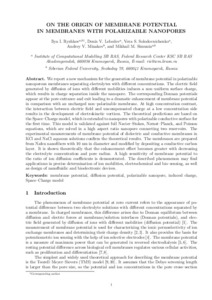Показать сокращенную информацию
On the origin of membrane potential in membranes with polarizable nanopores
| Автор | Ryzhkov, I. I. | |
| Автор | Lebedev, D. V. | |
| Автор | Solodovnichenko, V. S. | |
| Автор | Minakov, A. V. | |
| Автор | Simunin, M. M. | |
| Дата внесения | 2019-07-01T07:26:47Z | |
| Дата, когда ресурс стал доступен | 2019-07-01T07:26:47Z | |
| Дата публикации | 2018-03 | |
| Библиографическое описание | Ryzhkov, I. I. On the origin of membrane potential in membranes with polarizable nanopores [Текст] / I. I. Ryzhkov, D. V. Lebedev, V. S. Solodovnichenko, A. V. Minakov, M. M. Simunin // Journal of Membrane Science. — 2018. — Т. 549. — С. 616-630 | |
| ISSN | 03767388 | |
| URI (для ссылок/цитирований) | https://www.sciencedirect.com/science/article/pii/S0376738817327060?via%3Dihub | |
| URI (для ссылок/цитирований) | https://elib.sfu-kras.ru/handle/2311/110831 | |
| Аннотация | We report a new mechanism for the generation of membrane potential in polarizable nanoporous membranes separating electrolytes with different concentrations. The electric field generated by diffusion of ions with different mobilities induces a non–uniform surface charge, which results in charge separation inside the nanopore. The corresponding Donnan potentials appear at the pore entrance and exit leading to a dramatic enhancement of membrane potential in comparison with an uncharged non–polarizable membrane. At high concentration contrast, the interaction between electric field and uncompensated charge at a low concentration side results in the development of electrokinetic vortices. The theoretical predictions are based on the Space–Charge model, which is extended to nanopores with polarizable conductive surface for the first time. This model is validated against full Navier–Stokes, Nernst–Planck, and Poisson equations, which are solved in a high aspect ratio nanopore connecting two reservoirs. The experimental measurements of membrane potential of dielectric and conductive membranes in KCl and NaCl aqueous solutions confirm the theoretical results. The membranes are prepared from Nafen nanofibers with ∼10nm in diameter and modified by depositing a conductive carbon layer. It is shown theoretically that the membrane potential enhancement becomes greater with decreasing the electrolyte concentration and pore radius. A high sensitivity of membrane potential to the ratio of ion diffusion coefficients is demonstrated. The described phenomenon may find applications in precise determination of ion mobilities, electrochemical and bio–sensing, as well as design of nanofluidic and bioelectronic devices. © 2017 Elsevier B.V. | |
| Тема | Diffusion potential | |
| Тема | Induced charge | |
| Тема | Membrane potential | |
| Тема | Polarizable nanopore | |
| Тема | Space–Charge model | |
| Название | On the origin of membrane potential in membranes with polarizable nanopores | |
| Тип | Journal Article | |
| Тип | Journal Article Preprint | |
| Страницы | 616-630 | |
| ГРНТИ | 61.13.19 | |
| Дата обновления | 2019-07-01T07:26:47Z | |
| DOI | 10.1016/j.memsci.2017.11.073 | |
| Институт | Институт цветных металлов и материаловедения | |
| Институт | Институт космических и информационных технологий | |
| Институт | Институт инженерной физики и радиоэлектроники | |
| Подразделение | Кафедра композиционных материалов и физико-химии металлургических процессов | |
| Подразделение | Кафедра прикладной математики и компьютерной безопасности | |
| Подразделение | Кафедра теплофизики | |
| Журнал | Journal of Membrane Science | |
| Квартиль журнала в Scopus | Q1 | |
| Квартиль журнала в Web of Science | Q1 |

